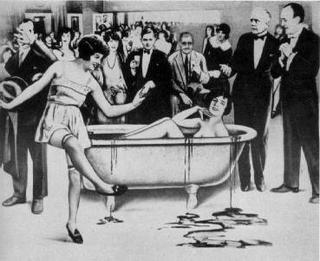
Discover Secrets Unspoken in a Speakeasy on West 56th Street that Mae West & George Raft Once Knew
.
.
Through July 21, when Film Forum (209 West Houston St.) is showcasing witty films that slipped the censors in its "Paramount Before the Code" series—including Mae West's screen debut [in "Night After Night"]—will any Big Apple history buffs be in the audience? Whose memory is sharp enough to detect New York nuggets built into this comedy set in a certain palatial rowhouse? Or has that once comforting tonic of shared narrative vanished like bathtub gin?
.
Club Napoleon: 33 West 56th Street
.
Before she read the script, Mae West knew about these premises on West 56th Street. So did George Raft, who had tangoed in speakeasies run by Texas Guinan and her brother, and patronized by Dorothy Parker along with literary "round table" types. It was Tommy Guinan and Sherman Billingsley who were the Pied Pipers of Club Napoleon, mixmasters who made the right ingredients pour in: bluebloods, showgirls, prizefighters, and pinky-ring types.
.
Club Napoleon’s escapades inspired a sly short story, "Single Night" by Louis Bromfield, which Mae West, Kathryn Scola, and Vincent Lawrence would fine-tune and finesse into a screenplay about a speak with the working title of Number 55. An address change couldn’t fool New Yorkers. Those in the know realized this was about "that house on Fifty-Sixth Street," which had been owned by Charles Donahue, whose ambitious brother had wooed and wed heiress Jessie Woolworth, worth $70,000,000 thanks to her grandfather, founder of the five-and-dime chain.
.
When this elegant five-story limestone mansion became the lavishly appointed speakeasy Club Napoleon, a repeat attender was Pulitzer winner Louis Bromfield [1896-1956]. Whiling away an afternoon with a news man, Bromfield noticed a stranger who ordered a drink, then threw it on the floor. Headwaiter Albert Berryman protested, whereupon the gent raved about being born in this very house and resenting its downturn into an illegal gin mill. He left without revealing his name. Not long after, on April 24, 1931, the cousin and legal guardian of the 18-year-old heiress Barbara Hutton made a splash on the front page of The New York Times; deep in debt, millionaire broker James Paul Donahue, 44, had doffed a chemical cocktail and committed suicide.
.
Louis Bromfield stirred these bitters into a creamier concoction, which he resold to Hollywood. Night After Night was intended as a vehicle for George Raft, featuring Constance Cummings and Texas Guinan, whose baubles were so substantial that she could signal ships with her jewelry. Though that part went to Mae West, the role of "Maudie Triplett" retained its Cartier cachet.
"Goodness!" cried the girl. "Are them diamonds real?"
"Yes, dearie," Mae West replied, "but goodness had nothing to do with 'em."
.
Another film with a similar slant was "The House on 56th Street," starring Kay Francis. Legends rapidly took shape about that location — especially after bootlegger Larry Fay renamed the club Casa Blanca, and met a spectacularly crimson-soaked death there on January 1, 1933.
.
But three months earlier, Mae had passed by en route to the Paramount Theatre. "Night After Night" premiered on October 29, 1932 to good reviews and she and Raft had a lot to celebrate.
.
This 500-word article was written by LindaAnn Loschiavo ©2005 All rights reserved.
.
Dramatist LindaAnn Loschiavo will offer excerpts from her play “Courting Mae West” [based on true events in Manhattan during the 1920s] at the Mae West Birthday Gala taking place on Wednesday evening August 17, 2005 at Bill’s Gay Nineties on East 54th Street.
- - -
http://maewest.blogspot.com/atom.xml
mae west
No comments:
Post a Comment